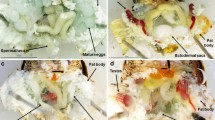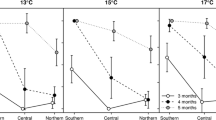Summary
Catops nigricans reproduces in the autumn. Pre-imaginal development is temperature-dependent and takes place during the winter, followed by aestivation in the early adult stage. This summer diapause is obligatory and temperature independent. It synchronizes the monovoltine life cycle with the annual cycle. In three populations collected near Kiel (54°22′ N, 10°6′ E), Köln (50°54′ N, 7°6′ E), and Paris (49°25′ N, 2°20′ E), pre-imaginal development slowed and the duration of summer diapause decreased with increasing latitude. Synchronization of the critical breeding interval with the appropriate environmental conditions was achieved through temperature- and photoperiod-dependent sensitivity of ovipositing adults, through different thermal thresholds in eggs, larvae, and pupae, and through sensitivity to photoperiod in third-instars larvae.C. nigricans copes with the unpredictability of climatic conditions in different ways. The local populations have evolved a mean diapause length which probably adjusts the life cycle in most years to the optimal date for reproduction. The mean diapause length was 77 days for Kiel, 98 days for Köln and 138 days for Paris at 10°C, short-day (=SD).C. nigricans also spreads the risk by varying diapause length. Amongthe progeny of single females the range of diapause duration covered about 70% of the total range of the whole population. The oviposition rate of females confined to subterranean life was the same as females confined to subterranean life was the same as in those living under the influence of a varying photoperiod.C. nigricans should therefore be able to live both in the litter layer of forests and also in the nests and galleries of small mammals.
Similar content being viewed by others
Abbreviations
- L3:
-
3rd larval instar
- SD:
-
short-day conditions (e.g. LD=8/16)
- LD:
-
long-day conditions (e.g. LD=16/8)
- DD:
-
continuous darkness, except controls (see above)
References
Bradshaw WE (1973) Homeostasis and polymorphism in vernal development ofChaoborus americanus. Ecology 54:1247–1259
Casale A (1975) Ciclo biologico e morfologia preimaginale di coleoptera Staphylinoides delle famiglie Leptinidae e Catopidae. Redia 56:199–230
Dingle H (1986) The evolution of insect life cycle syndromes. In: Taylor F, Karban R (eds) The evolution of insect life cycles. Springer, New York, pp 187–203
Engler I (1982) Vergleichende Untersuchungen zur jahreszeitlichen Einpassung von Catopiden (Col.) in ihren Lebensraum. Zool Jb Syst 109:399–432
Masaki S (1980) Summer diapause. Ann Rev Entomol 25:1–25
Müller HJ (1970) Formen der Dormanz bei Insekten. Nova Acta Leopoldina 35:1–27
Sachs L (1984) Angewandte Statistik, 6th ed. Springer, Berlin Heidelberg New York
Topp W (1976) Diapause und ihre bedeutung für den Entiwicklungszyklus der Insekten, am Beispiel der Staphylinidae und Catopidae (Coleoptera) Habil.-Schrift, Kiel
Topp W (1979) Vergleichende Dormanzuntersuchungen an Staphyliniden (Coleoptera). Zool Jb Syst 106:1–49
Topp W (1983) Limiting similarity in rove beetles of a habitat island. In: Margaris NS, Arianoutsou-Faraggitaki M, Reiter RJ (eds) Adaptations to terrestrial environments. Plenum Press, New York, pp 3–11
Topp W (1984) Synchronisation und polymorphe Termination der Diapause beiOxytelus rugosus (Grav.) (Col., Staphylinidae). Zool Jb Syst 111:521–542
Topp W (1986) Imaginal aestivation in the rove beetle speciesOmalium rivulare (Coleoptera: Staphylinidae) Entomol Gen 12:51–55
Topp W, Engler I (1980) Species packing in Catopidae (Col.) of a beech stand. Zool Anz 205:39–42
Wipking W (1988) Repeated larval diapause and diapause-free development in geographic strains of the burnet mothZygaena trifolii Esp. (Insecta, Lepidoptera). I. Discontinuous clinalvariation in photoperiodically controlled diapause induction. Oecologia 77:557–564
Wipking W, Neumann D (1986) Polymorphism in the larval hibernation strategy of the burnet moth,Zygaena trifolii. In: Taylor F, Karban R (eds) The evolution of insect life cycles. Springer, New York, pp 125–134
Author information
Authors and Affiliations
Rights and permissions
About this article
Cite this article
Topp, W. Selection for an optimal monovoltine life cycle in an unpredictable environment. Studies on the beetleCatops nigricans Spence (Col., Catopidae). Oecologia 84, 134–141 (1990). https://doi.org/10.1007/BF00665607
Received:
Accepted:
Issue Date:
DOI: https://doi.org/10.1007/BF00665607




